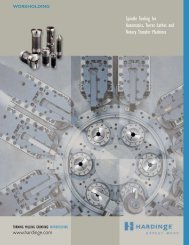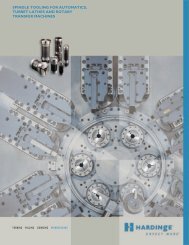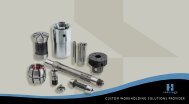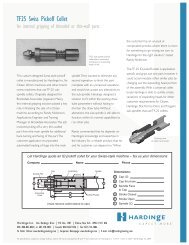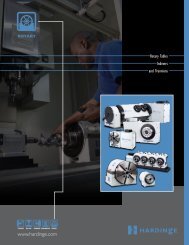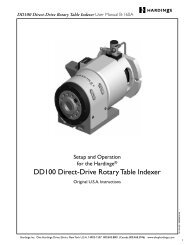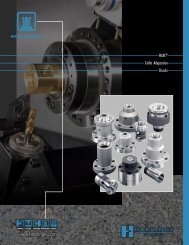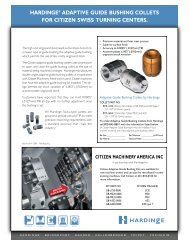You also want an ePaper? Increase the reach of your titles
YUMPU automatically turns print PDFs into web optimized ePapers that Google loves.
<strong>Sure</strong>-Grip ® <strong>Power</strong> <strong>Chuck</strong> Safety and Technical Manual B-87Z<br />
General Safety Information<br />
Before placing the Hardinge ® <strong>Sure</strong>-Grip ® <strong>Power</strong> <strong>Chuck</strong> on your machine tool, thoroughly read this manual and understand<br />
the information. If you are uncertain about any of the information, see your immediate supervisor. Also make certain that<br />
you understand the information in your machine tool operator’s, programmer’s and maintenance manuals.<br />
NOTICE<br />
Damage resulting from misuse, negligence or accidents<br />
is not covered by the Hardinge <strong>Sure</strong>-Grip <strong>Power</strong> <strong>Chuck</strong> Warranty.<br />
Information in this document is subject to change without notice.<br />
In no event will Hardinge Inc. be responsible for indirect or consequential damage<br />
resulting from the use or application of the product, or any of the information in this document.<br />
This product is only to be used by trained machinists skilled<br />
in the use and operation of power chucks on metal cutting machines.<br />
Machine Tool Setup/Operators Responsibilities:<br />
• Hazards may arise from the characteristics of the workpiece and machine used with a given workholding chuck<br />
even if the specific requirements in this manual are met. The user shall therefore consider such characteristics of<br />
workpieces (dimensions, mass and shape), and of machines (operating speed, feed and depth of cut) in order to<br />
remove or reduce the hazard.<br />
• The maximum permissible speed for the specific machining shall be determined by the user on the basis of the<br />
clamping forces required. This speed shall not exceed the maximum rotational speed of the workholding chuck.<br />
• For special top jaws, the user should calculate the dynamic clamping force for a particular workholding chuck<br />
according to the one method outlined in this manual. Other methods are available from publications referred to<br />
on page 118.<br />
• Static clamping force measuring devices should be used to check maintenance conditions at regular intervals<br />
according to the information in this manual.<br />
• Residual risks may arise from a failure to achieve a satisfactory quality of rotational balance.<br />
• To prevent excessive force being applied to a particular workholding chuck, the actuating force available from a<br />
machine may need to be reduced.<br />
– WARNINGS –<br />
Warnings must be followed carefully to avoid the possibility of personal injury and or damage to the chuck,<br />
machine tool, tooling, or the workpiece. In this publication the term "personal injury" should be understood<br />
to include severe personal injury, possibly resulting in death.<br />
– CAUTIONS –<br />
Cautions must be followed carefully to avoid the possibility of damage to the chuck,<br />
machine tool, tooling, or workpiece.<br />
– NOTES –<br />
Notes contain supplemental information.<br />
Hardinge Inc. One Hardinge Drive, Elmira, New York U.S.A. 14902-1507 800.843.8801 www.hardingetooling.com<br />
7



